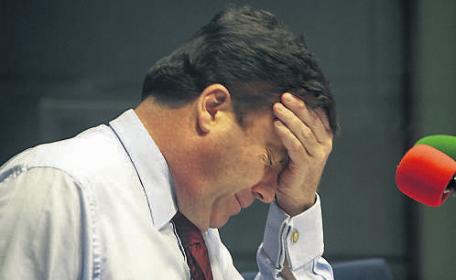Live Video - Bernanke Testifimony - House Budget Committee
Summaries from this morning's testimony:
CNN - Paul Ryan vs. BernankeC-Span - Congress wants answers from Bernanke---
Prepared Statement
Ben Bernanke
Chairman Ryan, Ranking Member Van Hollen, and other members of the Committee, I am pleased to have this opportunity to offer my views on the economic outlook, monetary policy, and issues pertaining to the federal budget.
The Economic OutlookThe economic recovery that began in the middle of 2009 appears to have strengthened in the past few months, although the unemployment rate remains high. The initial phase of the recovery, which occurred in the second half of 2009 and in early 2010, was in large part attributable to the stabilization of the financial system, the effects of expansionary monetary and fiscal policies, and the strong boost to production from businesses rebuilding their depleted inventories. But economic growth slowed significantly last spring and concerns about the durability of the recovery intensified as the impetus from inventory building and fiscal stimulus diminished and as Europe's fiscal and banking problems roiled global financial markets.
More recently, however, we have seen increased evidence that a self-sustaining recovery in consumer and business spending may be taking hold. Notably, real consumer spending rose at an annual rate of more than 4 percent in the fourth quarter. Although strong sales of motor vehicles accounted for a significant portion of this pickup, the recent gains in consumer spending appear reasonably broad based. Business
investment in new equipment and software increased robustly throughout much of last year, as firms replaced aging equipment and as the demand for their products and services expanded. Construction remains weak, though, reflecting an overhang of vacant and foreclosed homes and continued poor fundamentals for most types of commercial real estate. Overall, improving household and business confidence, accommodative monetary policy, and more-supportive financial conditions, including an apparently increasing willingness of banks to lend, seem likely to result in a more rapid pace of economic recovery in 2011 than we saw last year.
While indicators of spending and production have been encouraging on balance, the job market has improved only slowly. Following the loss of about 8-3/4 million jobs from 2008 through 2009, private-sector employment expanded by a little more than 1 million in 2010. However, this gain was barely sufficient to accommodate the inflow of recent graduates and other new entrants to the labor force and, therefore, not enough to significantly erode the wide margin of slack that remains in our labor market. Notable declines in the unemployment rate in December and January, together with improvement in indicators of job openings and firms' hiring plans, do provide some grounds for optimism on the employment front. Even so, with output growth likely to be moderate for a while and with employers reportedly still reluctant to add to their payrolls, it will be several years before the unemployment rate has returned to a more normal level. Until we see a sustained period of stronger job creation, we cannot consider the recovery to be truly established.
On the inflation front, we have recently seen increases in some highly visible prices, notably for gasoline. Indeed, prices of many industrial and
agricultural commodities have risen lately, largely as a result of the very strong demand from fast-growing emerging market economies, coupled, in some cases, with constraints on supply. Nonetheless, overall inflation is still quite low and longer-term inflation expectations have remained stable. Over the 12 months ending in December, prices for all the goods and services consumed by households (as measured by the price index for personal consumption expenditures) increased by only 1.2 percent, down from 2.4 percent over the prior 12 months. To assess underlying trends in inflation, economists also follow several alternative measures of inflation; one such measure is so-called core inflation, which excludes the more volatile food and energy components and therefore can be a better predictor of where overall inflation is headed. Core inflation was only 0.7 percent in 2010, compared with around 2-1/2 percent in 2007, the year before the recession began. Wage growth has slowed as well, with average hourly earnings increasing only 1.7 percent last year. These downward trends in wage and price inflation are not surprising, given the substantial slack in the economy.
Monetary PolicyAlthough the growth rate of economic activity appears likely to pick up this year, the unemployment rate probably will remain elevated for some time. In addition, inflation is expected to persist below the levels that Federal Reserve policymakers have judged to be consistent over the longer term with our statutory mandate to foster maximum employment and price stability. Under such conditions, the Federal Reserve would typically ease monetary policy by reducing its target for the federal funds rate. However, the target range for the federal funds rate has been near zero since December 2008, leaving essentially no room for further reductions. As a consequence, since then we have been using alternative tools to provide additional monetary accommodation. In particular, over the past two years the Federal Reserve has further eased monetary conditions by purchasing longer-term securities--specifically, Treasury, agency, and agency mortgage-backed securities--on the open market. These purchases are settled through the banking system, with the result that depository institutions now hold a very high level of reserve balances with the Federal Reserve.
Although large-scale purchases of longer-term securities are a different monetary policy tool than the more familiar approach of targeting the federal funds rate, the two types of policies affect the economy in similar ways. Conventional monetary policy easing works by lowering market expectations for the future path of short-term interest rates, which, in turn, reduces the current level of longer-term interest rates and contributes to an easing in broader financial conditions. These changes, by reducing borrowing costs and raising asset prices, bolster household and business spending and thus increase economic activity. By comparison, the Federal Reserve's purchases of longer-term securities do not affect very short-term interest rates, which remain close to zero, but instead put downward pressure directly on longer-term interest rates. By easing conditions in credit and financial markets, these actions encourage spending by households and businesses through essentially the same channels as conventional monetary policy, thereby strengthening the economic recovery. Indeed, a wide range of market indicators suggest that the Federal Reserve's securities purchases have been effective at easing financial conditions, lending credence to the view that these actions are providing significant support to job creation and economic growth.
1My colleagues and I have said that we will review the asset purchase program regularly in light of incoming information and will adjust it as needed to promote maximum employment and stable prices. In particular, we remain unwaveringly committed to price stability, and we are confident that we have the tools to be able to smoothly and effectively exit from the current highly accommodative policy stance at the appropriate time. Our ability to pay interest on reserve balances held at the Federal Reserve Banks will allow us to put upward pressure on short-term market interest rates and thus to tighten monetary policy when needed, even if bank reserves remain high. Moreover, we have developed additional tools that will allow us to drain or immobilize bank reserves as needed to facilitate the smooth withdrawal of policy accommodation when conditions warrant. If necessary, we could also tighten policy by redeeming or selling securities.
As I am appearing before the Budget Committee, it is worth emphasizing that the Fed's purchases of longer-term securities are not comparable to ordinary government spending. In executing these transactions, the Federal Reserve acquires financial assets, not goods and services; thus, these purchases do not add to the government's deficit or debt. Ultimately, at the appropriate time, the Federal Reserve will normalize its balance sheet by selling these assets back into the market or by allowing them to run off. In the interim, the interest that the Federal Reserve earns from its securities holdings adds to the Fed's remittances to the Treasury; in 2009 and 2010, those remittances totaled about $125 billion.
Fiscal PolicyFiscal policymakers also face significant challenges. Our nation's fiscal position has deteriorated appreciably since the onset of the financial crisis and the recession. To a significant extent, this deterioration is the result of the effects of the weak economy on revenues and outlays, along with the actions that the Administration and the Congress took to ease the recession and steady financial markets. However, even after economic and financial conditions return to normal, the federal budget will remain on an unsustainable path, with the budget gap becoming increasingly large over time, unless the Congress enacts significant changes in fiscal programs.
For example, under plausible assumptions about how fiscal policies might evolve in the absence of major legislative changes, the Congressional Budget Office (CBO) projects the deficit to fall from its current level of about 9 percent of gross domestic product (GDP) to 5 percent of GDP by 2015, but then to rise to about 6-1/2 percent of GDP by the end of the decade.
2In subsequent years, the budget situation is projected to deteriorate even more rapidly, with federal debt held by the public reaching almost 90 percent of GDP by 2020 and 150 percent by 2030, up from about 60 percent at the end of fiscal year 2010.
The long-term fiscal challenges confronting the nation are especially daunting because they are mostly the product of powerful underlying trends, not short-term or temporary factors. The two most important driving forces behind the budget deficit are the aging of the population and rapidly rising health-care costs. Indeed, the CBO projects that federal spending for health-care programs will roughly double as a percentage of GDP over the next 25 years.
3The ability to control health-care spending, while still providing high-quality care to those who need it, will be critical for bringing the federal budget onto a sustainable path.
The CBO's long-term budget projections, by design, do not account for the likely adverse economic effects of such high debt and deficits. But if government debt and deficits were actually to grow at the pace envisioned, the economic and financial effects would be severe. Sustained high rates of government borrowing would both drain funds away from private investment and increase our debt to foreigners, with adverse long-run effects on U.S. output, incomes, and standards of living. Moreover, diminishing investor confidence that deficits will be brought under control would ultimately lead to sharply rising interest rates on government debt and, potentially, to broader financial turmoil. In a vicious circle, high and rising interest rates would cause debt-service payments on the federal debt to grow even faster, resulting in further increases in the debt-to-GDP ratio and making fiscal adjustment all the more difficult.
In thinking about achieving fiscal sustainability, it is useful to apply the concept of the primary budget deficit, which is the government budget deficit excluding interest payments on the national debt. To stabilize the ratio of federal debt to the GDP--a useful benchmark for assessing fiscal sustainability--the primary budget deficit must be reduced to zero.
4Under the CBO projection that I noted earlier, the primary budget deficit is expected to be 2 percent of GDP in 2015 and then rise to almost 3 percent of GDP in 2020 and 6 percent of GDP in 2030. These projections provide a gauge of the adjustments that will be necessary to attain fiscal sustainability. To put the budget on a sustainable trajectory, policy actions--either reductions in spending, increases in revenues, or some combination of the two--will have to be taken to eventually close these primary budget gaps.
By definition, the unsustainable trajectories of deficits and debt that the CBO outlines cannot actually happen, because creditors would never be willing to lend to a government with debt, relative to national income, that is rising without limit. One way or the other, fiscal adjustments sufficient to stabilize the federal budget must occur at some point. The question is whether these adjustments will take place through a careful and deliberative process that weighs priorities and gives people adequate time to adjust to changes in government programs or tax policies, or whether the needed fiscal adjustments will come as a rapid and painful response to a looming or actual fiscal crisis. Acting now to develop a credible program to reduce future deficits would not only enhance economic growth and stability in the long run, but could also yield substantial near-term benefits in terms of lower long-term interest rates and increased consumer and business confidence. Plans recently put forward by the President's National Commission on Fiscal Responsibility and Reform and other prominent groups provide useful starting points for a much-needed national conversation. Although these proposals differ on many details, they demonstrate that realistic solutions to our fiscal problems do exist.
Of course, economic growth is affected not only by the levels of taxes and spending, but also by their composition and structure. I hope that, in addressing our long-term fiscal challenges, the Congress and the Administration will undertake reforms to the government's tax policies and spending priorities that serve not only to reduce the deficit, but also to enhance the long-term growth potential of our economy--for example, by reducing disincentives to work and to save, by encouraging investment in the skills of our workforce as well as new machinery and equipment, by promoting research and development, and by providing necessary public infrastructure. Our nation cannot reasonably expect to grow its way out of our fiscal imbalances, but a more productive economy will ease the tradeoffs that we face.
Thank you. I would be pleased to take your questions.










